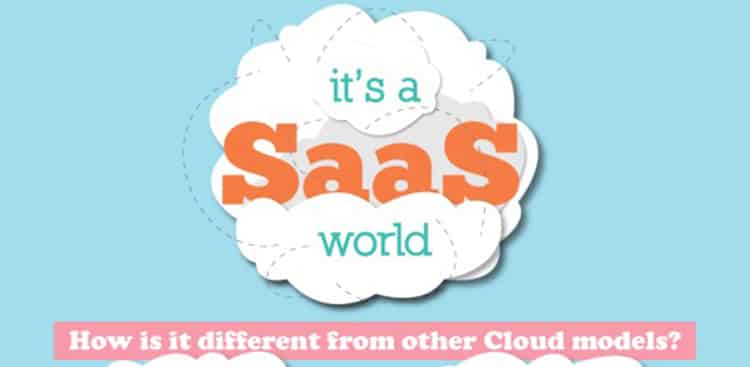Software as a service (SaaS) is a software licensing and delivery model in which software is centrally hosted and licensed on a subscription basis. SaaS is accessed by users using a thin client via a web browser. SaaS has become a delivery model for many business applications. Some examples are payroll processing software, DBMS, Project Management software, CAD software, virtualization, accounting, customer relationship management (CRM), and much more.
The platform has given a lot of scope to freelance web developers and overall freelance community who do not have access to infrastructure. SaaS is a part of the strategy of most of the leading enterprise software companies. According to the market research, the SaaS revenue has crossed $20 billion marks. The ‘Software as a Service’ term is part of the nomenclature of cloud computing, along with Infrastructure as a Service and Platform as a service (PaaS).
Software Distribution:
For the cloud (or SaaS) model, there is no need for indirect distribution because there is no physical distribution. The initial SaaS companies built their economic model without including partner remuneration in their pricing structure. It was not easy for traditional software publishers to use the SaaS model after a long-term experience of working with on-premise servers. Today, a business model is taking shape with SaaS and managed service players who combine the indirect sales model with their existing business model, and those who seek to redefine their role within the IT economy.
SaaS Architecture:
The majority of SaaS solutions are multitenant architectures. With this model, a single version of the application, with one configuration (hardware, network, operating system), is used for all customers (“tenants”). For scalability, you install the application on multiple machines, which is also known as horizontal scaling. Another version of the application is set up by some businesses to provide few customers access to pre-release versions of the applications for testing purposes.
It contrasts with traditional installed software, where multiple physical copies of the software each potentially of a different version, with a potentially different configuration are present across various customer sites. A few SaaS solutions do not use multitenancy, but those are exceptional, or that is a requirement by Customer or a specific Industry.
There are two main ways of SaaS:
A Software which answers the needs of a specific industry (e.g., healthcare, agriculture, finance, etc.) is called Vertical SaaS. The one which focuses on a Software category (marketing, sales, developer tools, HR) but spread across industries is called Horizontal SaaS.
SaaS has considerably reduced the Startup development costs. Think of the products and services you had to buy when starting a B2C or B2B software company ten years ago, and that you can now rent. These include servers, productivity suites, software development tools and project management and CRM software.
Advantages of using SaaS Platform:
Lower Cost: With SaaS, you pay for what you need without buying additional hardware to host new applications. The vendor performs much of the work to get their software working for you and your business.
The time to a working solution can drop from months in the traditional model to weeks, days or hours with the SaaS model. In the case of funding software and its implementation, this can be a make-or-break issue for the sales and marketing budget, so the lower cost makes a difference for them.
Reduced time of prototyping: In the SaaS model, the software application is available to users as an installed and configured Application. Users can provision the server for the cloud and quickly have the application ready for use. It reduces the time to benefit and allows for rapid demonstrations and prototyping.
Smaller MVP (Minimum Viable Product): Since your software is online and multi-tenant, you can upgrade it frequently without any distribution costs or downtime for clients. It lets you start smaller and faster, and build up your features as your Startup grows.
Better user experience: Plugging Google Analytics into your SaaS application gives you precious user feedback to adjust your product roadmap.
Upgrades, Uptime, and Security: Under the SaaS model, since the vendor takes responsibility for maintaining the software and upgrading it, ensuring that it is reliable and meeting service level agreements and keeping the application and its data secure.
Work anywhere: Since the software is hosted in the cloud and accessible over the Internet, users can access it via mobile devices wherever they are connected. It includes checking customer order histories before a sales call, as well as having access to real time data and real time order taking with the customer. For freelance gigs, the ability to access the software and data when they need it can change the nature of a sale.
Faster scaling: Your software is online, giving you instant access to international markets and increasing your chances of reaching scale. Creating logins and passwords will always be easy with hosted software.
Pay as you go: SaaS software gives you the benefit of known costs of subscription and administration. Even as you scale, you can have a clear idea of what your costs will be. It allows for much more accurate budgeting compared to the costs of internal IT to manage upgrades and address issues.
Streamlined sales process: The SaaS sales and marketing process considerably reduces sales and marketing expenses and lets you focus on what matters. It may be a cost to bear at the start of your business, and you may consider it heavy for a Startup, but need to consider it as set-up cost.
An Example of Great SaaS:
When Startups go looking for executive talent, they want someone with some experience working with a successful organization as many of them may have freelance work experience. For Cloud Computing, there is a scarcity of expertise with an exception Salesforce. Perhaps, that’s why Salesforce, by far the most successful pure SaaS company ever, has become a pipeline for executive talent. There are many Startups which started these days with just a few laptops with them, and this revolution is mainly the result of SaaS model.



